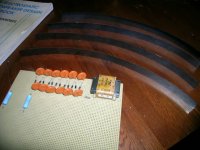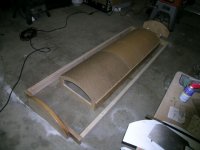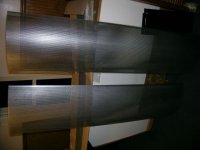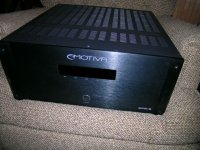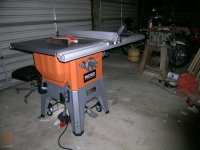The "curved" table really doesn,t mean much in the sense that you can stretch horizontally all you want and it will come out that way! No Way! ML is simply pulling slightly " horizontally" to eliminate wrinkles along with considerable tension vertically. Notice that over the years they have added more spacers closer together..,. Seems obvious to me and could be wrong,, that a curve is diffucult to control long term that more closely spacing cures. They would say this is for frequency response conturing and not anything else., but I don't think so even though it will change it.. It might tighten impulse response at higher frequency,s where curved panels are a mess compared to flat panels.
Owning SL3,s for many years and comparing them to my Quads, all I can say personally, I think a curved eletrostatic "looks like and feels like the ultimate way to go" but fails miserably because its not a perfect rational piston due to improper ratios of tension across the diaphram material in both directions.
Flat panels are superior in this and more consistant, but of course very
directional by nature. Directionality has benefits in the right rooms if your
concerned with decay reflections.
Curved sure looks good and gives dispersion but gives up too much in long
term listening pleasure overall IMHO.
I would hate to see you go all the way and be disapointed but thats the nature of DIY and sometimes you suprise yourself ans really like it!
Regards
David
Owning SL3,s for many years and comparing them to my Quads, all I can say personally, I think a curved eletrostatic "looks like and feels like the ultimate way to go" but fails miserably because its not a perfect rational piston due to improper ratios of tension across the diaphram material in both directions.
Flat panels are superior in this and more consistant, but of course very
directional by nature. Directionality has benefits in the right rooms if your
concerned with decay reflections.
Curved sure looks good and gives dispersion but gives up too much in long
term listening pleasure overall IMHO.
I would hate to see you go all the way and be disapointed but thats the nature of DIY and sometimes you suprise yourself ans really like it!
Regards
David
Well, I figured out how to make the tabletop, so all is good there.
Hi AVWERK, I see you own the sl3, and also quads...
What quads do you own, and what are the major differences in sound?
Do you think that the ML's sound inferior by a large margin?
Hi AVWERK, I see you own the sl3, and also quads...
What quads do you own, and what are the major differences in sound?
Do you think that the ML's sound inferior by a large margin?
Iv'e received my perforated panels, and it seems there is very little in the way of burrs.
That being said, I still need to de-burr and was wondering what method (s) you all have used to get the best results.
Emery Cloth? Wire Wheel? What?
Cheers
-wreck
That being said, I still need to de-burr and was wondering what method (s) you all have used to get the best results.
Emery Cloth? Wire Wheel? What?
Cheers
-wreck
Last edited:
Hi,
why do You think, the ML should sound inferior?
A curved panel is compromised, yes, but so is every panel and every acoustic transducer. The Quads are inherently flawed too, resulting in terribly inefficient panels and a vastly reduced dynamic range.
Imho, if one decides for flat panels the tall, strip shaped segmented panels of Acoustat or Audiostatic style are the way to go.
Older ML panels for example were glued together only at the very to and bottom rim, nothing in between. This simple and cheap manufacture was prone to rattling noises and other effects, probabely even for the criticized messy "impulse response" (whatever the critic thinks that is, or from whatever 'measurement' that clue was taken from).
Anyway, every tightly stretched membrane will show the 'messy' response regardless of its shape due to reflections at the surrounding membrane fixtures and low internal damping.
While adding damping certainly reduces the visible amount of mess it doesn't solve the problem.
Mechanical damping measures do introduce their own sonic footprint, namely sonic boredom if overdone.
Why should different tensions in vertical and horizontal direction be negative for a non-circular shaped panel with different dimensions in vertical and horizontal direction?
I certainy would like to know how the critic thinks he could create a homogenous mechanical tension gradient over the whole surface of a rectangular or strip shaped panel.
jauu
Calvin
why do You think, the ML should sound inferior?
A curved panel is compromised, yes, but so is every panel and every acoustic transducer. The Quads are inherently flawed too, resulting in terribly inefficient panels and a vastly reduced dynamic range.
Imho, if one decides for flat panels the tall, strip shaped segmented panels of Acoustat or Audiostatic style are the way to go.
A curved panel requires indeed more care and effort to keep the shape long term.that a curve is diffucult to control long term that more closely spacing cures. They would say this is for frequency response conturing and not anything else., but I don't think so even though it will change it. It might tighten impulse response at higher frequency,s where curved panels are a mess compared to flat panels.
Older ML panels for example were glued together only at the very to and bottom rim, nothing in between. This simple and cheap manufacture was prone to rattling noises and other effects, probabely even for the criticized messy "impulse response" (whatever the critic thinks that is, or from whatever 'measurement' that clue was taken from).
Anyway, every tightly stretched membrane will show the 'messy' response regardless of its shape due to reflections at the surrounding membrane fixtures and low internal damping.
While adding damping certainly reduces the visible amount of mess it doesn't solve the problem.
Mechanical damping measures do introduce their own sonic footprint, namely sonic boredom if overdone.
Why should a perfect pistonic behaviour be the opimum for membranes much larger than the wavelengths of the reproduced frequencies? Panel speakers working after distributed resonance principle and Mangers for sure proove different!... but fails miserably because its not a perfect rational piston due to improper ratios of tension across the diaphram material in both directions.
Why should different tensions in vertical and horizontal direction be negative for a non-circular shaped panel with different dimensions in vertical and horizontal direction?
I certainy would like to know how the critic thinks he could create a homogenous mechanical tension gradient over the whole surface of a rectangular or strip shaped panel.
jauu
Calvin
Compromise and choice and realities
What Calvin says is true of course. the ML,s do have more dynamic range, but the 57,s have downward dynamic range that exceeds the ML,s even though overall the quads have total limited loudness capability, nothing new here. The Quads IMO have overall balance and the ML have no midbass to speak of, just an uneven presentation that doesn't pull me in like an excellent speaker should. Flashy first listening impressions always leave me cold in the end.
I,m speculating on what I hear and why looking at how they are constructed, waterfall plots, ringing diaphrams out of control, listening, etc. Waterfall plots easily show us what control that diaphragm has or doesn,t.
If you were to spread out a ML panel flat and remeasure, I (speculate) it would have more control over movement than curved since its impossible to tension its area equaly in all directions. I see less compromise with flat stretched film even though not perfect, and better long term listening of flat panels. Sanders recent examples sound outstanding.
I am speculating only, and just don,t see force over area in a ML diaphragm in the unequal way the mylar is applied, looking at graphs , comparisons, reviews, etc.
I appreciate your considerable Knowledge and have learmed alot from your posts, but I know what I hear and " think " I know why based on Constantly changing out these examples I own.
Regards
David
What Calvin says is true of course. the ML,s do have more dynamic range, but the 57,s have downward dynamic range that exceeds the ML,s even though overall the quads have total limited loudness capability, nothing new here. The Quads IMO have overall balance and the ML have no midbass to speak of, just an uneven presentation that doesn't pull me in like an excellent speaker should. Flashy first listening impressions always leave me cold in the end.
I,m speculating on what I hear and why looking at how they are constructed, waterfall plots, ringing diaphrams out of control, listening, etc. Waterfall plots easily show us what control that diaphragm has or doesn,t.
If you were to spread out a ML panel flat and remeasure, I (speculate) it would have more control over movement than curved since its impossible to tension its area equaly in all directions. I see less compromise with flat stretched film even though not perfect, and better long term listening of flat panels. Sanders recent examples sound outstanding.
I am speculating only, and just don,t see force over area in a ML diaphragm in the unequal way the mylar is applied, looking at graphs , comparisons, reviews, etc.
I appreciate your considerable Knowledge and have learmed alot from your posts, but I know what I hear and " think " I know why based on Constantly changing out these examples I own.
Regards
David
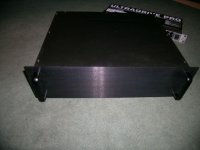 Thanks Calvin and AVWERK, lots of good information to ponder!
Thanks Calvin and AVWERK, lots of good information to ponder!Like I have stated before, once I build these curved panels, my work will not cease. My attention (then) will be focused on building a floor to ceiling, segmented (probably wire) set of ESL's similar to what member 'golfnut' has built, as this seems to be an excellent design with a solid white paper supporting it. (Thanks to bolserst for pointing out that link.)

On a side-note, not a lot comes up when one types in "segmented ESL build' into Google's search engine..

That (to me) means that Charlie still holds the winning reigns for a complete step-by-step guide for ESL construction... Nice goin' Charlie!🙂
However, there was one that I came across that was quite detailed, it's over at The Audio Circuit, and even includes an amp design.
link: Do It Yourself - Electrostatic Speakers - Project: ESL-220-30 by Marc Schroeyers
In the meantime, I took possession of an empty enclosure that I ordered from Par-Metal, it's a rack-mount (3R) unit that will house all of the associated electronics my new build will need, take a look at the attachment: 🙂
Last edited:
Nice looking case !!!
The Marc Schoeyers project is a most excellent write up.
Unfortunately TAC only shows some of the article, I have the complete article printed out as it was when it First hit the web.
I learned a lot from that build as it goes into every detail from his amp selection to Transformer design as well crossovers and integrated dipole woofer.
jer 🙂
The Marc Schoeyers project is a most excellent write up.
Unfortunately TAC only shows some of the article, I have the complete article printed out as it was when it First hit the web.
I learned a lot from that build as it goes into every detail from his amp selection to Transformer design as well crossovers and integrated dipole woofer.
jer 🙂
Hi,
David´s arguments are perfectly right from his experience with ML Panels.
But while anybody interested in this field of sound reproduction can certainly learn a hellot of sensible things byy examining those panels, they are not the only panels of this style of construction and certainly not the cream of the crop.
ML used to use 12µm thick coated membrane material off of the shelf, while the Quads used thinner stuff. There´s a sonic difference between materials of different thickness, with lowlevel resolution improving with reduced thickness.
No one is hindered to use <6µm membranes in their curved DIY-Panels also.
The lack in tonal balance of the MLs is mostly due to the inconsistancies between panel and bass. Apart from their Statement2 they never managed to integrate bass and panel seamlessly. But again this is no inherent flaw of curved panels, but of a compromised implementation. It takes indeed some effort, but perfect integration of bass and panel and tonal balance at least on par with the Quads and combined with a vastly increased dynamic range are possible.
No Highs, no lows ...
... it must be Bose
No lows, no highs, and no dynamics ...
... it must be Quad, Yo Manics. 😀

jauu
Calvin
David´s arguments are perfectly right from his experience with ML Panels.
But while anybody interested in this field of sound reproduction can certainly learn a hellot of sensible things byy examining those panels, they are not the only panels of this style of construction and certainly not the cream of the crop.
ML used to use 12µm thick coated membrane material off of the shelf, while the Quads used thinner stuff. There´s a sonic difference between materials of different thickness, with lowlevel resolution improving with reduced thickness.
No one is hindered to use <6µm membranes in their curved DIY-Panels also.
The lack in tonal balance of the MLs is mostly due to the inconsistancies between panel and bass. Apart from their Statement2 they never managed to integrate bass and panel seamlessly. But again this is no inherent flaw of curved panels, but of a compromised implementation. It takes indeed some effort, but perfect integration of bass and panel and tonal balance at least on par with the Quads and combined with a vastly increased dynamic range are possible.
No Highs, no lows ...
... it must be Bose
No lows, no highs, and no dynamics ...
... it must be Quad, Yo Manics. 😀


jauu
Calvin
On a side-note, not a lot comes up when one types in "segmented ESL build' into Google's search engine..
Yeah, some time I need to post a more step-by-step build process on segmented wire ESLs...just never seem to get around to it.
I've posted pics and descriptions of the build process, but not all in one place.
In the mean time, you can take a look a two Dutch(Google Translated) build guides posted some time back:
http://www.diyaudio.com/forums/plan...-esl-project-file-translated.html#post2241752
http://www.diyaudio.com/forums/plan...-esl-project-file-translated.html#post2243663
That thread is fairly short, but has some good information, pics, and links to related info.
Last edited:
As for Charlie holding the reins (I ride English... "reighns" must be Western (per Wreckingball)) on ESL building, a concept to which I completely agree, I finished my Jazzman Mk 4s last week and played them all day Saturday. They sound great. Now if they last as long as my Lucas ESLs (17 years and counting) they will be passed on to my heirs! The Mk 4s, BTW, use Jazzman's latest method of wrapping the D/S foam and polyester tape around the stator edges, and "clamping" the stators in place in the enclosure...
As for Charlie holding the reins (I ride English... "reighns" must be Western (per Wreckingball)) on ESL building, a concept to which I completely agree, I finished my Jazzman Mk 4s last week and played them all day Saturday. They sound great. Now if they last as long as my Lucas ESLs (17 years and counting) they will be passed on to my heirs! The Mk 4s, BTW, use Jazzman's latest method of wrapping the D/S foam and polyester tape around the stator edges, and "clamping" the stators in place in the enclosure...
Hey let's see some pics!
Hey let's see some pics!
Yea! What he said! lol
Btw, I am not dead, neither is this thread, I'm just waiting on transfos from the UK.
Process pics minyana...
Yea! What he said! lol
Btw, I am not dead, neither is this thread, I'm just waiting on transfos from the UK.
Process pics minyana...
Hey, I'm waiting to see your pics also !
Looking forward to seeing this.It would nice to have all the info in one place
Thanks
Andrew
Thanks
Andrew
Yeah, some time I need to post a more step-by-step build process on segmented wire ESLs...just never seem to get around to it.
I've posted pics and descriptions of the build process, but not all in one place.
In the mean time, you can take a look a two Dutch(Google Translated) build guides posted some time back:
http://www.diyaudio.com/forums/plan...-esl-project-file-translated.html#post2241752
http://www.diyaudio.com/forums/plan...-esl-project-file-translated.html#post2243663
That thread is fairly short, but has some good information, pics, and links to related info.
Looking forward to seeing this.It would nice to have all the info in one place
Thanks
Andrew
I'll second that motion! Anyone else? (pile on please)
Well I've been getting everything together at a snail's pace, but that's OK, as my trafos won't be here till late Jan.
I eluded to the fact earlier, that I was going to order my perf metal with a remaining margin, that is not going to be the case as it would have cost me an additional $120 to do so...not gonna happen.
I decided to find a different way to facilitate a solid perimeter, and it came in the form of material known as "common banding" around these parts...
Yea, that's right, the stuff they use to bind together pallets of merchandise in order to ship it. This stuff is easily obtainable, and can be cut with common shears.
I originally wanted to epoxy it to the panel before powder coating, but unless you special order high-temp epoxy, common epoxies will only withstand around 350F, and powder coating ovens are usually 400F.
So I'm just going to have this banding powder coated at the same time as the panels, and epoxy later. On the plus side, this stuff is easy to bend by hand and should provide the necessary surface for the VHB tape to adhere to...
See pic:
You can also see in the foreground my soon-to-be bias supply, that will have taps at 3.8 (or so) kV, and another at 5.1kV. 😱
I had my panels curved by a skilled metal worker, who made sure that they were exactly 30 degrees, cost me 56 bucks, but I think it was worth it> see pic:
I'm almost done with my stretching jig too, the cookbook calls for one that is 50-70% bigger than the actual ESL. See pic:
Finally, did any of you guys ever notice that when you decide to embark on a new mission, that you current equipment just won't do..haha
Pics of the new table saw, with the old POS in the background...haha, and also pics of the new XPA-5 I ordered for driving these new ESLs.
Cheers
-wreck
I eluded to the fact earlier, that I was going to order my perf metal with a remaining margin, that is not going to be the case as it would have cost me an additional $120 to do so...not gonna happen.
I decided to find a different way to facilitate a solid perimeter, and it came in the form of material known as "common banding" around these parts...
Yea, that's right, the stuff they use to bind together pallets of merchandise in order to ship it. This stuff is easily obtainable, and can be cut with common shears.
I originally wanted to epoxy it to the panel before powder coating, but unless you special order high-temp epoxy, common epoxies will only withstand around 350F, and powder coating ovens are usually 400F.
So I'm just going to have this banding powder coated at the same time as the panels, and epoxy later. On the plus side, this stuff is easy to bend by hand and should provide the necessary surface for the VHB tape to adhere to...
See pic:
You can also see in the foreground my soon-to-be bias supply, that will have taps at 3.8 (or so) kV, and another at 5.1kV. 😱
I had my panels curved by a skilled metal worker, who made sure that they were exactly 30 degrees, cost me 56 bucks, but I think it was worth it> see pic:
I'm almost done with my stretching jig too, the cookbook calls for one that is 50-70% bigger than the actual ESL. See pic:
Finally, did any of you guys ever notice that when you decide to embark on a new mission, that you current equipment just won't do..haha
Pics of the new table saw, with the old POS in the background...haha, and also pics of the new XPA-5 I ordered for driving these new ESLs.
Cheers
-wreck
Attachments
Last edited:
Four pieces measuring 15" by 60" plus two remainder 6"x 60" (for a future center channel) perforated 20 gauge metal, cut out of their stock 36"x120" sheets... final price was $113 and some change, straight to my door, not bad.
(I'm happy 🙂)
Stay tuned...
Hi Wreckingball,
I'm following your build closely, another Noob.😱
Can you give more info on the stators, hole size, open percentage etc.
Thanks
Hi keyboard 123,
I just realized that the post you quoted from me contains a typo, price should read 214 and not 113. As far as metal goes, like I said, it's thickness is 20 gauge, the holes are 5/32" on 3/16" centers, 63 percent open, and was cut from a sheet that was originally 36" by 120".
You can have them do a number of things to it like deburring, curving, powder coating etc. I just wanted to have those things done locally where I'd have more control over the outcome.
Hope this helps. ..
I just realized that the post you quoted from me contains a typo, price should read 214 and not 113. As far as metal goes, like I said, it's thickness is 20 gauge, the holes are 5/32" on 3/16" centers, 63 percent open, and was cut from a sheet that was originally 36" by 120".
You can have them do a number of things to it like deburring, curving, powder coating etc. I just wanted to have those things done locally where I'd have more control over the outcome.
Hope this helps. ..
- Status
- Not open for further replies.
- Home
- Loudspeakers
- Planars & Exotics
- Building a large curved ESL
